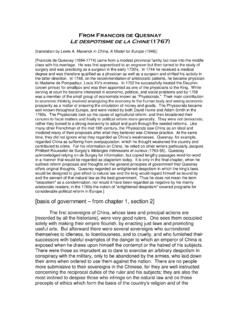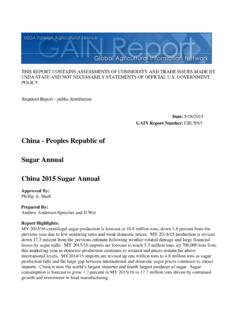Transcription of China Tax Alert - Deloitte US
1 International Tax China Tax Alert 21 September 2015 SAT issues draft guidance on transfer pricing rules and BEPS initiatives China 's State Administration of Taxation (SAT) released a discussion draft of "Special Tax Adjustment Implementation Measures" (Draft) on 17 September 2015 that would comprehensively revise Circular 2, the existing guidance in this area. Circular 2, issued in 2009, is China s main transfer pricing guidance that contains detailed rules in areas such as transfer pricing adjustments, cost sharing arrangements (CSAs), controlled foreign companies (CFCs), thin capitalization, the general anti-avoidance rule (GAAR), etc. The Draft also incorporates a number of recommendations of the OECD in the context of the base erosion and profit shifting (BEPS) initiative, but does so taking into account China s unique economic environment and factors relevant to the revamping of Circular 2.
2 The Draft also includes new chapters addressing intangible assets, intragroup services tr ansactions and profit level monitoring. The SAT is seeking public comments on the Draft by 16 October 2015. Summary of key points in the Draft Transfer pricing contemporaneous documentation would consist of amaster file and local report(s). Enterprises that meet certain criteria wouldbe required to complete and submit the country-by-country (CbC)reporting form with their annual Enterprise Income Tax (EIT) returns(Chapters 2 and 3). Taxpayers would be required to prepare a special issue report as part ofthe contemporaneous documentation if they engaged in related partyservices transactions, implemented CSAs or exceeded the prescribedthin capitalization ratio at any time during the year (Chapters 3, 7, 9 and11).
3 During the course of a special tax investigation, if the ultimate globalholding company of the investigated enterprise is located outside Chinaand that holding company did not provide a CbC report to its local taxauthorities, or the Chinese tax authorities are unable to effectively obtainthe CbC report of the ultimate global holding company under anapplicable automatic exchange of information agreement, the Chinese taxauthorities would have the power to request that the investigatedenterprise provide a CbC report. The tax authorities also would considerlocation-specific advantages (LSA), such as location savings, marketContacts Eunice Kuo Liantang He Patrick Cheung premium, etc. when determining whether any additional profits should be attributed to the investigated enterprise (Chapters 5 and 6).
4 The Chinese tax authorities would adopt a broader approach in monitoring the profit levels of taxpayers and taxpayers would be assigned risk rankings. Taxpayers would not only have to comply with the contemporaneous documentation and related party disclosure requirements, but also would need to monitor their day-to-day transfer pricing policy implementation and potentially their profit levels (Chapter 13). The Draft also provides a number of clarifications that would be welcomed by taxpayers: The value contribution method and asset valuation method would be formally introduced as examples of other acceptable transfer pricing methods, but the Draft clearly affirms the importance of considering traditional transfer pricing methods (Chapter 4).
5 The requirement that CSAs be pre-approved by the tax authorities would be abolished and changes would be made to post-CSA monitoring, which would provide flexibility for taxpayers that intend to implement CSAs (Chapter 9). The tax authorities should impose additional tax and/or refund overpaid tax, as appropriate, based on the outcome of a mutual agreement procedure (MAP) in order to eliminate any double taxation arising from a special tax adjustment. Although the Draft sets out situations where applications for a MAP would be denied, it would provide flexibility for the SAT to ignore these criteria in situations where it considers that the MAP would eliminate double taxation, etc. Details of the Draft Chapter 2: Reporting of related party transactions The Draft contains a number of clarifications relating to the recognition of associated relationships.
6 For example, the Draft would: Clarify the calculation for combining the shareholding percentage of two or more individuals who have a familial relationship; Provide a method for calculating the ratio of total debt owed by a party to the actual paid-in capital; Include licensing of trademarks as one of the determination factors for associated relationship; In the case of know-how licensing, distinguish between patented know-how and non-patented know-how; Emphasize the meaning of primary control and common interest, and provide an explanation of primary control, a clear definition of senior management personnel, and stipulate that a family relationship should be considered as one factor in determining whether an associated relationship exists.
7 The Draft also would clarify that a shareholding by the state or an association through the delegation of senior personnel by the state to a party would not give rise to an associated relationship. These clarifications are designed to help the Chinese tax authorities make better practical determinations of the existence of associated relationships. The Draft would modify and provide additional clarifications of various types of related party transactions. Transfers of financial assets, cash pooling arrangements and equity transfers would be considered related party transactions and other types of transactions would be added as a catch-all category. The Draft would require that the CbC form be submitted with the PRC Annual Related Party Transactions Reporting Form in the annual EIT tax return.
8 The Draft also sets out the criteria for the CbC reporting where a Chinese enterprise is the ultimate holding company of a multinational group and the annual consolidated revenue of the group of the previous fiscal year exceeds RMB 5 billion (equivalent to the EUR billion threshold mentioned by the OECD), or where the ultimate holding company of the enterprise is outside China and the China enterprise has been designated by the multinational group to prepare and submit the CbC report. Chapter 3: Contemporaneous documentation On the basis of the existing version of Circular 2, the Draft draws on the BEPS 13 Action Plan and states that there would be three types of transfer pricing contemporaneous documentation: the master file, local report(s) and report(s) on special issues that would cover related party services transactions, CSAs and thin capitalization.
9 This is consistent with the domestic initiative to focus on significant outbound service fee and royalty payments, as set out in guidance issued in 2014 and earlier this year (Circular 146 and Bulletin 16). The requirement to prepare the contemporaneous documentation report, master file and local report(s) would be subject to the same threshold as is found in the current version of Circular 2, the report would be required where the aggregate amount of related party purchases and sales exceeds RMB 200 million or the aggregate amount of other related party transactions exceeds RMB 40 million. However, the Draft also would require enterprises with limited functions and that incur losses to prepare a master file and local report(s).
10 The Draft also would eliminate the requirement that the foreign shareholding percentage be lower than 50% and that the related party transactions only be between domestic associated parties in Circular 2, so that an enterprise that only had related party transactions with domestic related parties would not be required to prepare the documentation report. The Draft clearly indicates that if a taxpayer provides false or incomplete information that does not truly reflect the company's related party transactions, the taxpayer would be considered to have failed to comply with the contemporaneous documentation requirement. This implies that the tax authorities may impose stricter requirements on the quality of documentation, as well as disclosure requirements.



















